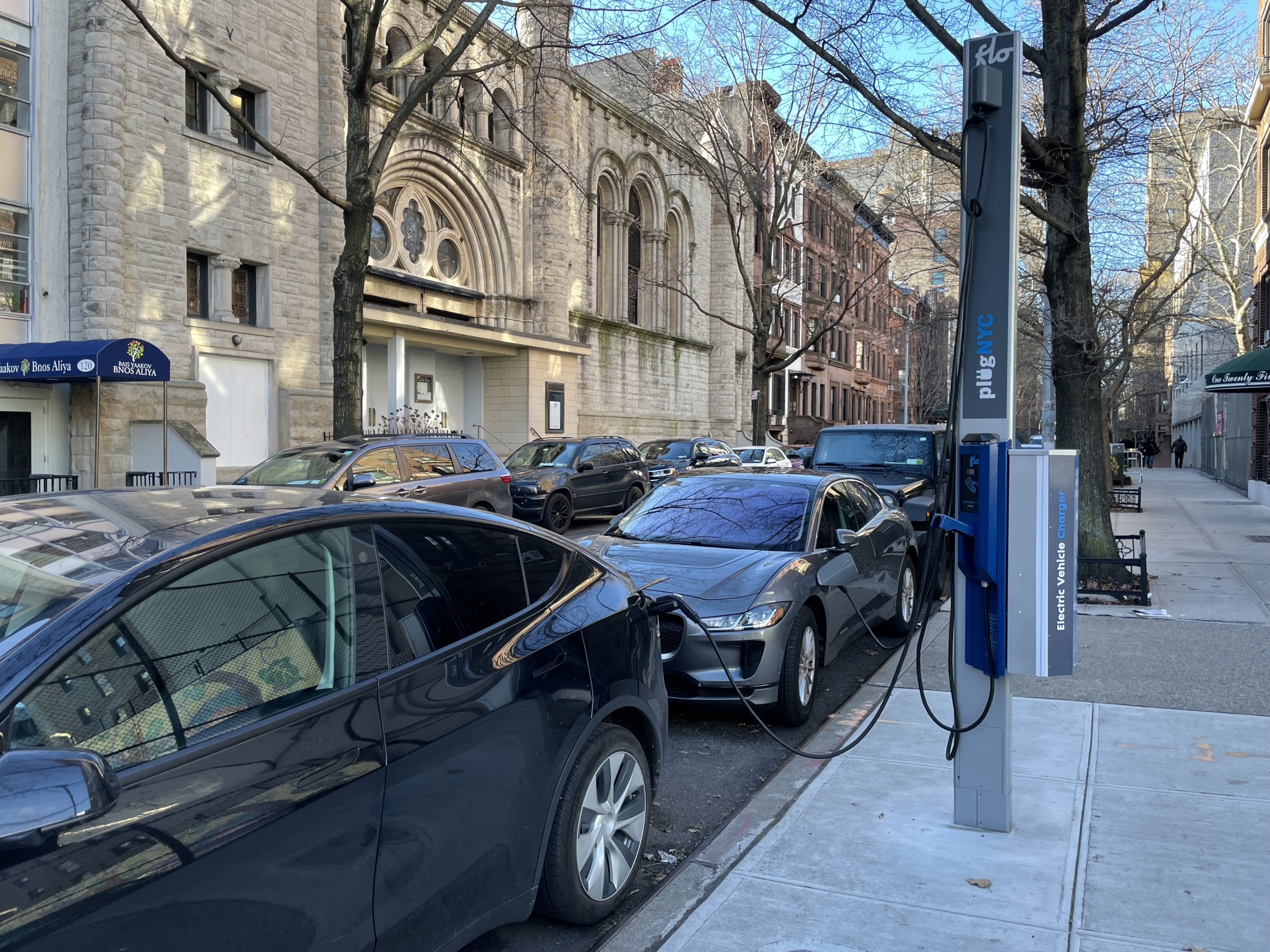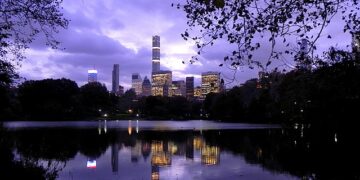
By Scott Etkin
The transportation sector is the city’s second largest source of pollution, behind only buildings, accounting for almost a third of greenhouse gas emissions. So, it’s good news that the use of New York’s network of public curbside electric vehicle (EV) chargers is on the rise, according to a new report from the Department of Transportation (DOT).
The chargers were in use 99.9% of the time from July 2021 to December 2022, the findings showed, and the overall utilization rate of the system grew from 14% to 34% in the second year of the study. The three chargers on the Upper West Side were among the most used in the city.
“From month to month, the ten sites that were most heavily used — based on utilization and monthly session count — are, with one exception, on the Upper West Side and Upper East Side of Manhattan, and in Carroll Gardens and Park Slope in Brooklyn,” the report says. One reason the UWS uses its public chargers this much is because its EV adoption rate is “at the minimum, twice as high as the citywide average.”
The Upper West Side’s three public curbside charging stations, which have two plugs each, recorded the following usage in December 2022:
- 76th Street between Amsterdam and Columbus had 126 sessions (46% utilization rate)
- 84th Street between Amsterdam and Columbus had 136 sessions (50% utilization rate)
- 93rd Street between Columbus and Central Park West had 171 sessions (60% utilization rate)
Across the system, nearly 79% of charging sessions occurred during peak hours (6 a.m. to 9 p.m.) and 21% occurred overnight. The median charging session length was just over three hours.
“The program’s utilization and reliability has exceeded the agency’s expectations,” DOT said, but challenges remain. One problem is that gas-powered cars park in spaces reserved for EV charging. “Blocked charger spaces will likely remain an issue, but present more of an inconvenience to users than a fundamental challenge to the program’s effectiveness.”









Would be curious about the numbers/percentage of Manhattan residents.
Right, out of towers are coming here to use our slow chargers.
Jim –
It is possible people from other boroughs and out of town visiting have need to charge.
If your goal is to access reserved on-street parking in Manhattan, then a slow charger might be preferable. Drive into the city, plug in your car in your reserved spot, charge up, go to a show or the museum, drive back to Long Island.
They need to come up with a way to make sure that these spots are only used by charging EVs – pull in, charge, and leave. Given how hard it is to find street parking, an empty spot is a very valuable commodity.
What is the energy source for these charging stations. I am generally supportive of electric vehicles but I sometimes wonder if many of them are being charged off of grids that are powered by natural gas so aren’t as virtuous as they seem…
Even so, generating pollution in a controlled way through a power plant in a less dense spot is MUCH preferable to each individual car spewing smog in the densest city in America. There are not thousands of children with asthma living alongside each rural power plant.
This “EVs make smog at the power plant” argument just makes no sense.
Yes, creating energy can be and likely is “dirty.” But at least these cars don’t spew out exhaust as they move about the city. That itself is virtuous.
The median charging session length was just over three hours.
And the chargers were in use 99% of the time. What this tells me is that if I get an electric vehicle I need to be prepared to wait 3 hours for someone else to finish charging before I can pull up. This is what prevents me from getting one.
I take delivery of my Tesla Model Y in 10 days. Believe me, an apartment dweller on the UWS, I looked into the charging situation carefully. Take a look at the ChargePoint app. You’ll find the three UWS curbside charging stations mentioned in the article. Expand the map so it shows both charging stations as the site. Tap on each one: it will tell you if it is available. You can actually put yourself “in line” through the app; however, if people just leave their cars parked at the station until the next ASP window of opportunity, that could be a problem.
Does this mean people who don’t have or use the app can’t use the chargers? If someone happens to see an open spot are they not allowed to charge their vehicle?
Who pays for this?? Why not focus on diesel from school buses, ice cream trucks, sanitation vehicles and box trucks? That’s what is harming us. This is ludicrous.
It is a bit of a “scam” to guarantee EV drivers a parking spot all the time. An EV charges in a few hours, depending on the make and amount of juice it needs. They are only supposed to stay in the spot while actually charging. But most EV drivers park their car there and leave it there until the next alternate side day, long after its charge is complete. Taking up the space that another car could park and/or another EV pull in and charge
These spots should be metered. You pay to park there and can only use the spot for a limited amount of time. And make it so that only EV’s can use them. Given how few of the spots there are I’m OK with that. This seems like a really easy solution.
The other day in the course of walking my dog on Riverside Drive I counted 7 Tesla’s either parked or in motion. In fact, I see any number of Teslas on any given day. Their increasing ubiquity suggests more curbside charging stations are needed.
Indeed, it seems to me the large parking in Riverside Park, in the vicinity of West 96th Street, just off the Southbound lanes of the West Side Highway present an opportunity to install a whole raft of chargers including some high-speed Level 1 chargers. This area is also accessible from the Northbound lanes at the U-trn opportunity just north of the 96th Street entrance.
If NYC is serious about promoting the use of EV’s they’ve got to do a lot better than just 3 curbside locations on the UWS. There are other charging stations, too, but they are flor the most part in parking garages – one pays for parking in addition to the electricity, virtually the cost of a tank of gas.
Why shouldn’t one pay for parkong in addition to the electricity? You are getting both
We still have to catch up to California! https://babylonbee.com/news/governor-newsom-to-require-all-toddler-racecar-beds-be-electric-by-2030
According to the Rag less than a year ago, the EVs parking in thr spots aren’t always charging their cars. It’s just really cheap parking.
https://www.westsiderag.com/2022/07/06/the-bumpy-road-to-electric-vehicle-ownership-on-the-upper-west-side
I’ve seen electric vehicles not charging using these spaces.